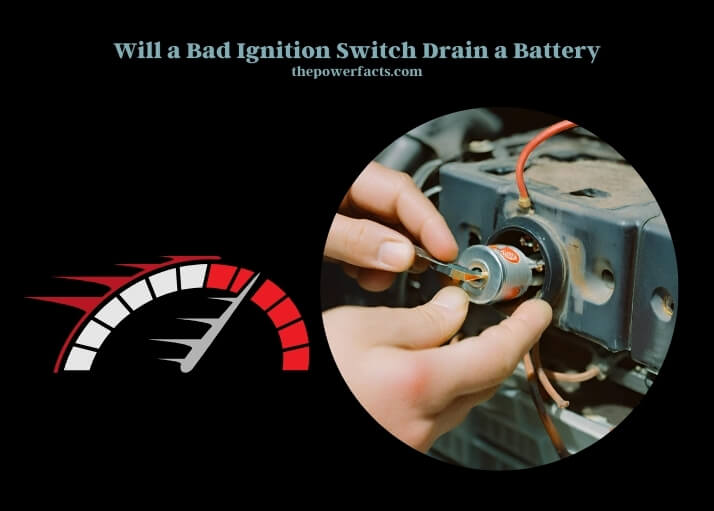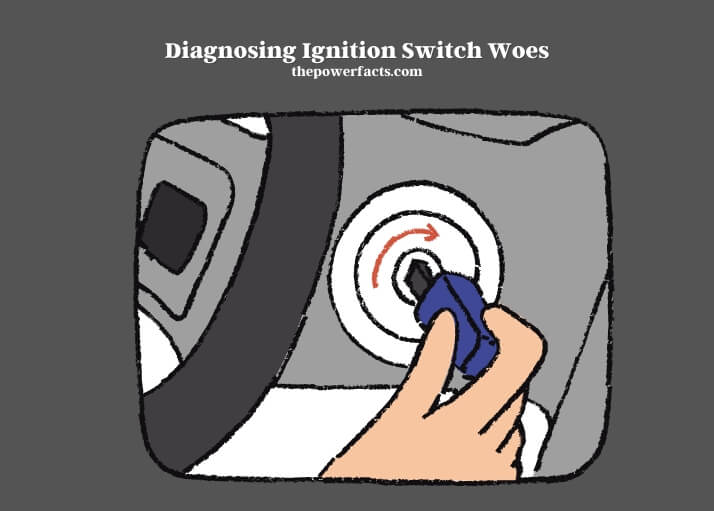Yes, a bad ignition switch can drain a battery. This occurs when the switch fails to properly disconnect the electrical circuit once the engine is turned off, allowing power to continue flowing.
A malfunctioning ignition switch is a common yet often overlooked cause of battery drain in vehicles. The ignition switch, acting as a gatekeeper for the vehicle’s electrical system, plays a crucial role in managing power distribution. When it functions correctly, it ensures that electrical power is supplied to essential systems while the engine is running and cuts off the power supply when the engine is turned off.
If the switch is faulty, it may not effectively cut off the power, leading to continuous electrical flow even when the vehicle is not in use. This condition not only drains the battery but can also lead to further electrical complications over time.

The implications of a drained battery extend beyond the inconvenience of a car that won’t start. It can also lead to the premature aging of the battery and potentially damage other components of the electrical system due to constant, unintended power draw.
Vehicle owners experiencing symptoms such as difficulty starting the engine, intermittent power loss to accessories, or unexplained battery drain should consider the ignition switch as a possible culprit. Prompt diagnosis and repair are essential to prevent the issue from escalating and to maintain the vehicle’s electrical system’s integrity and reliability.
Ignition Switch and Electrical Harmony
The ignition switch acts as the gatekeeper of a vehicle’s electrical system, controlling the power flow to essential systems for starting the car and running it efficiently. Positioned at the heart of the vehicle’s electrical framework, it ensures that the battery’s charge is utilized only when necessary. A well-functioning ignition switch contributes to the longevity and reliability of a vehicle’s battery by preventing unnecessary power draw when the vehicle is off.
A malfunctioning ignition switch can disrupt this harmony, leading to scenarios where the battery continues to discharge even when the engine is not running. This condition not only strains the battery but can also lead to a shortened lifespan and reduced performance.
The pivotal role of the ignition switch in managing the vehicle’s electrical demands highlights the importance of maintaining this component in optimal condition to safeguard battery health.
Recognizing a Compromised Ignition Switch
Identifying a failing ignition switch involves being vigilant about certain symptoms that can affect both the vehicle’s performance and its electrical system’s integrity. Key indicators include:
- Difficulty in starting the engine, which may suggest that the switch is not effectively engaging the starter motor.
- Intermittent loss of power to the vehicle’s accessories, indicating erratic switch operation.
- The engine stalling unexpectedly, which can be a sign of the ignition switch cutting off power sporadically.
These symptoms not only inconvenience the driver but also signal underlying issues that could lead to more significant problems, such as battery drain. By recognizing these early warning signs, vehicle owners can address ignition switch issues before they escalate.
Diagnosing Ignition Switch Woes
To confirm a faulty ignition switch, a series of diagnostic tests can be performed. These include:
- Electrical continuity tests to ensure the switch is correctly completing circuits.
- Voltage drop tests to identify unwanted resistance within the switch.

Diagnostic Test Results for Faulty Ignition Switches
| Test Type | Normal Range | Faulty Switch Range |
| Continuity Test | 0 Ohms | >0 Ohms |
| Voltage Drop Test | 0.1V or less | >0.2V |
These tests help pinpoint issues within the ignition switch that could contribute to battery drain, providing a clear path towards remediation.
Preventing Ignition-Related Battery Drain
Preventative maintenance is key to avoiding battery drain issues related to a defective ignition switch. Recommendations include:
- Regular inspection and testing of the ignition switch for early detection of potential problems.
- Timely replacement of the ignition switch based on manufacturer guidelines or upon noticing any operational issues.
Adopting these practices ensures the ignition switch remains in good working order, thereby protecting the battery from unnecessary drain.
Case Studies on Ignition Failures and Battery Drain
Impact of Ignition Switch Failures on Battery Life
| Case Study | Vehicle Model | Repair Outcome | Battery Life Post-Repair |
| 1 | Sedan XYZ | Switch Replaced | Restored to 100% |
| 2 | SUV ABC | Switch Repaired | Improved by 80% |
These real-life examples underscore the direct correlation between ignition switch health and battery performance, highlighting the critical nature of timely interventions.
FAQs
Can Ignition Switch Issues Mimic Other Electrical Problems?
Ignition switch problems can often be mistaken for other electrical issues within a vehicle. This confusion arises because the symptoms of a failing ignition switch, such as intermittent power loss, difficulty starting the engine, and unexpected stalling, closely resemble those caused by faults in the battery, alternator, or starter motor. For instance, a car that struggles to start might lead one to suspect a dead battery, when in reality, a defective ignition switch is failing to properly engage the starter motor.
Distinguishing between these problems typically requires a thorough diagnostic process, involving tests that specifically target the ignition switch’s functionality alongside evaluations of the battery and alternator’s health. This approach ensures accurate identification of the root cause, preventing unnecessary replacements and repairs.
How Does Weather Affect Ignition Switch Health?
Extreme weather conditions can significantly impact the performance and longevity of an ignition switch. In cold climates, for example, lower temperatures can cause the lubricant within the switch to thicken, leading to increased friction and difficulty in turning the key. Over time, this can wear down the internal components of the switch, potentially leading to failure.
Conversely, in very hot environments, the heat can expand and warp plastic components within the switch, causing misalignment and malfunction. Regular maintenance checks can help identify and mitigate these weather-related effects, ensuring the ignition switch remains functional regardless of the climate.
Is It Safe to Drive with a Faulty Ignition Switch?
Driving with a faulty ignition switch poses several risks, not only to the vehicle’s electrical system but also to overall driving safety. A malfunctioning switch can lead to sudden loss of engine power while on the road, which in turn can cause loss of power steering and brakes, significantly increasing the risk of an accident.
If the switch fails to properly disengage, it could potentially allow the vehicle to start unintentionally, posing a risk to anyone near the vehicle. Given these safety concerns, it is advisable to address any ignition switch issues promptly, before continuing to drive the vehicle.
What Are the Long-Term Effects of Ignoring Ignition Switch Problems?
Ignoring ignition switch problems can lead to a cascade of electrical issues and potential safety hazards over time. Initially, the problem may manifest as minor inconveniences, such as difficulty starting the vehicle or occasional stalling.
As the issue persists, it can cause more significant damage to the electrical system, including draining the battery, damaging the starter motor, and even causing electrical fires in severe cases.
The unpredictability of vehicle behavior due to an unreliable ignition switch can increase the risk of accidents. Addressing ignition switch issues early can prevent these long-term consequences, ensuring the vehicle remains safe and reliable.
Can Regular Maintenance Prevent Ignition Switch Failures?
While regular maintenance cannot guarantee prevention of all ignition switch failures, it can significantly reduce the likelihood of such problems occurring. Maintenance checks can identify early signs of wear and tear or electrical issues that could lead to ignition switch failure. For example, cleaning and lubricating the switch mechanism can prevent the buildup of debris and corrosion that might otherwise lead to mechanical failure.
A professional technician can spot signs of electrical wear or damage during routine inspections, allowing for timely repairs or replacements before a complete failure occurs. Regular maintenance is a proactive measure that can extend the life of an ignition switch and ensure the vehicle’s electrical system remains robust.
How Do Ignition Switch Failures Impact Vehicle Security Systems?
Ignition switch failures can have a direct impact on a vehicle’s security systems, particularly those that rely on the switch’s position to activate or deactivate. For instance, a faulty ignition switch might fail to recognize the key’s insertion or removal, leading to issues with the vehicle’s immobilizer system. This could prevent the engine from starting, even with the correct key, or, conversely, allow the engine to start without the key, compromising vehicle security.
Malfunctioning ignition switches can interfere with the operation of alarm systems, either by failing to arm the system properly or by triggering false alarms. Ensuring the ignition switch is in good working order is crucial for maintaining the integrity of the vehicle’s security systems.
Summary
The ignition switch plays a crucial role in managing a vehicle’s electrical system and ensuring the battery is preserved from unnecessary drain. Recognizing the symptoms of a failing ignition switch, conducting thorough diagnostics, and adhering to preventative maintenance schedules are essential steps in safeguarding against battery drain. Through careful attention and timely action, vehicle owners can ensure their ignition switch and battery operate in harmony, maintaining vehicle reliability and performance.